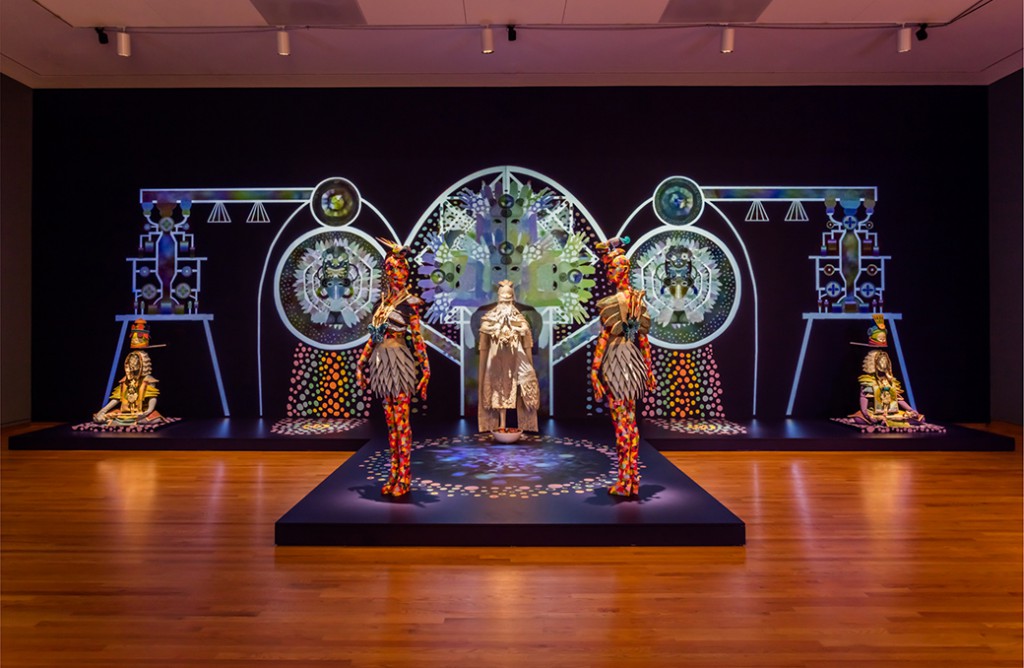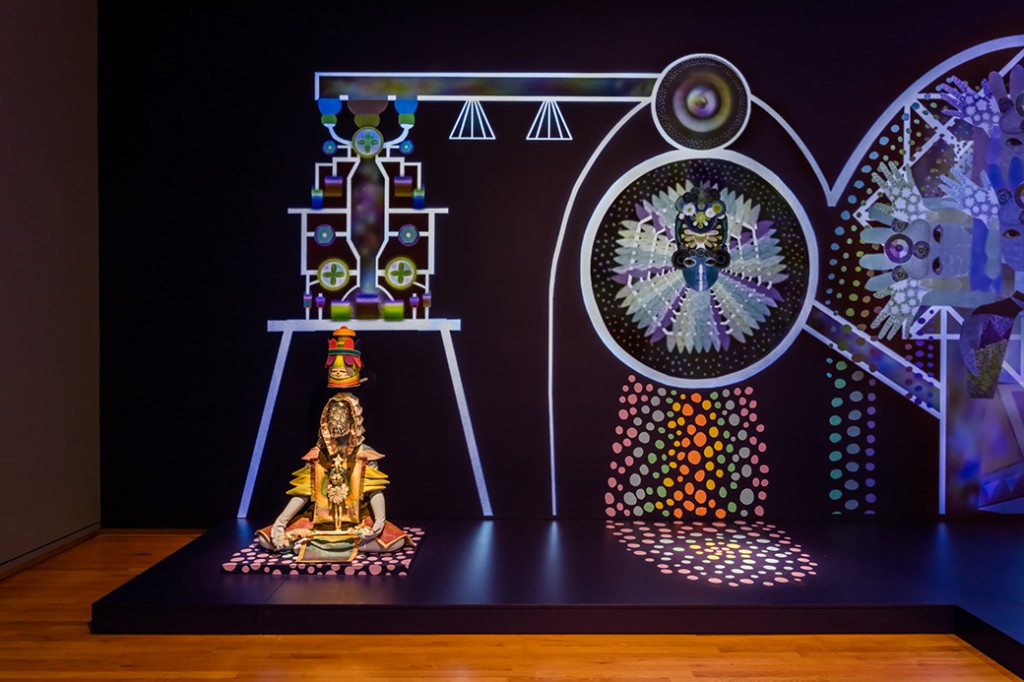
Saya Woolfalk. ChimaTEK Life Products, 2015; installation view, Disguise: Masks and Global African Art, 2015, Seattle Art Museum. © Seattle Art Museum. Photo: Nathaniel Willson.
In July 2015, when I encountered the installation by the New York–based artist Saya Woolfalk in the Disguise: Masks and Global African Art exhibition at the Seattle Art Museum, I felt like I’d entered an ecstatic, sci-fi world inhabited by cyborgs and unfathomable technology. In a darkened room, mandalas painted on the walls flickered while rainbow-patterned mannequins wore elaborate, fantastical costumes with glittery, butterfly-like embellishments, skirts with triangular pieces of fabric layered like reptilian scales, and headdresses topped with small chimeras. A video advertised the products of a company called ChimaTEK, including a combustion chamber and a hybridization machine. In art installations, futuristic tropes can sometimes appear cold or colorless, but Woolfalk’s sculptures, textiles, paintings, music, and video seemed to vibrate with warmth and pleasure.
One month later, I met Woolfalk in her Manhattan studio, where she explained to me that pleasure is the entry point for the work. As I described my feelings of euphoria inside her installation, Woolfalk said, “I’m not trying to make people happy, but I want to give [viewers] some sense of psycho-social pleasure.”[i] Many of the materials in Woolfalk’s installation are intentionally craft-based; a DIY aesthetic permeates the installation. Moreover, the craft materials connect Woolfalk’s work to artists such as Faith Ringgold and Miriam Schapiro, feminist artists who incorporated sewing and embroidery to challenge its exclusion from a fine art context. Woolfalk, who was born in Japan and grew up in Scarsdale, New York, learned from her grandmother to make traditional Japanese garments as a child. Her delight in the physical construction of these garments is palpable inside the ChimaTEK installation.
While the bright, richly patterned garments and paintings lured me into Woolfalk’s installation, the ChimaTEK video veered into darker territory. The designers of the “life products” described in the video are a fictional people called the Empathics. Woolfalk uses this group to explore narratives of hybridization and appropriation in contemporary culture. “The Empathics are a deeply contextual people,” Woolfalk told me. Their identities shift with context, and this constant shifting of both context and meaning points to the current appetite for cultural pastiche. For example, on a recent trip to Oaxaca, Woolfalk saw Indian (South Asian) textiles for sale at a market that specializes in traditional Mexican clothing. When a particular product is merged with foreign products or contexts, its cultural significance becomes malleable and can be compromised.
The products that the Empathics create for ChimaTEK also present a troubling mix of confused origins and intentions. For example, one of the products is an avatar download station, which allows a user to download another person’s history. In this case, the available avatars have been limited to the 999 women memorialized in Judy Chicago’s The Dinner Party (1974–79). This restriction resulted from a site-specific iteration of the ChimaTEK installation at the Elizabeth A. Sackler Center for Feminist Art, in the Brooklyn Museum of Art, where Chicago’s installation is permanently housed. Whereas Chicago’s multimedia work honors historic women of Western civilization, Woolfalk’s video uses these figures as a data set for the Empathics and their problematic quest for self-actualization.
The aforementioned video describes the first step of the avatar download process, in which the user inhales a vapor. With this, the user’s personal history is wiped clean and replaced with a selected avatar such as Sappho or Sacajawea. Downloading the avatar erases memories of the former self. The new version of the avatar is then uploaded to a virtual space, where it can interact with others. The desired result of this process is self-improvement, but its implication is improvement at the cost of the self.
The subtext of this exchange prompts a question that has been asked for centuries by Eastern philosophers: does happiness exist at the expense of one’s ego? Woolfalk, who has invited spiritual practitioners to lead meditations inside some of her installations, believes that American culture is having a “Buddhist moment.” Associations with Buddhism power the sales of a wealth of paraphernalia, like high-end yoga gear and iPhone meditation apps. Oddly, Americans are accessorizing their personal identities with material goods erroneously linked to a religion that rejects the very idea of the individual. With similar logic, the Empathics desire fulfillment through destruction.
When I asked Woolfalk if the Empathics are a happy people, she replied, “I don’t think they know a state of happiness that is continuous, but they are seeking.” In fact, the Empathics are constantly searching for self-transformation and self-improvement. Through ChimaTEK and its products, they find answers and perhaps fleeting moments of joy. Because these feelings are impermanent, the Empathics are continually moving forward. Happiness is not a static state but rather a perpetual search.
For almost a decade, Woolfalk has lived a double life: as an artist and also as an Empathic. She has trespassed all their lands and has been the mastermind behind ChimaTEK’s line of life products. Like the Empathics, Woolfalk hopes to be moving forward, concluding this grand saga over the next year. Woolfalk said she doesn’t know what will come next, but she is searching. And with that, Woolfalk mentioned that she feels happy.

Saya Woolfalk. ChimaTEK Life Products, 2015; installation view, Disguise: Masks and Global African Art, 2015, Seattle Art Museum. © Seattle Art Museum. Photo: Nathaniel Willson.
—
Saya Woolfalk (born 1979, Japan) holds a BA from Brown University and an MFA from the School of the Art Institute of Chicago. Her work has been shown in a number of galleries and institutions, including the Montclair Art Museum; the Studio Museum in Harlem; Museum of Contemporary Art, Chicago; and MoMA PS1.
[i] All of Woolfalk’s quotes are from a conversation on August 24, 2015, in the artist’s studio, New York, New York.



